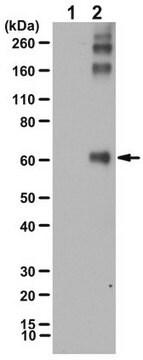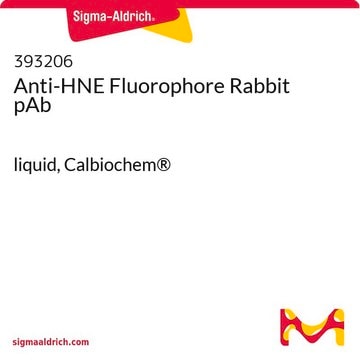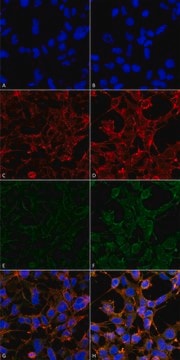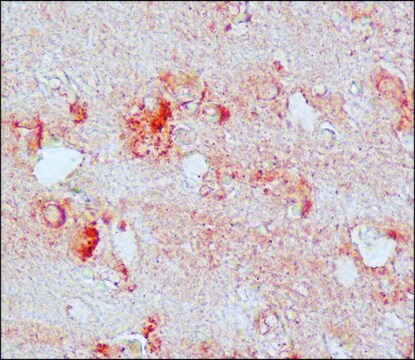AB5605
Anti-4-Hydroxynonenal Antibody
serum, Chemicon®
Synonym(s):
4-HNE
Sign Into View Organizational & Contract Pricing
All Photos(1)
About This Item
UNSPSC Code:
12352203
eCl@ss:
32160702
NACRES:
NA.41
Recommended Products
biological source
goat
Quality Level
antibody form
serum
antibody product type
primary antibodies
clone
polyclonal
species reactivity
human
manufacturer/tradename
Chemicon®
technique(s)
ELISA: suitable
western blot: suitable
shipped in
dry ice
target post-translational modification
unmodified
General description
The peroxidation of membrane lipids by free radicals is a well-controlled, ongoing process that occurs during normal cell turnover and the normal aging process. There is also the uncontrolled process of free radical production and increased lipid peroxidation that is associated with hepatic injury as a consequence of exposure to halogenated hydrocarbons, excessive alcohol abuse, and acute or chronic iron overload. Excess free radical production and lipid peroxidation is thought to be an etiological factor in such diseases as atherosclerosis, diabetes, genetic hemochromatosis, cancer and neurodegenerative diseases, such as Alzheimer′s and Parkinson′s disease.4-Hydroxynonenal (HNE) is a highly reactive, cytotoxic aldehyde that is released during the oxidation of w-6-unsaturated fatty acids. HNE can efficiently react with sulfhydryl groups or histidine and lysine groups of proteins to form stable HNE-protein adducts, in addition to phospholipids and nucleic acids. It is through this HNE-modification of biomolecules that HNE is thought to exert its cytotoxic effects. This multifunctional molecule may be considered as a "second toxic messenger," which disseminates and augments initial free radical events. It is believed to be largely responsible for the cytopathological effects observed during oxidative stress. High levels of 4-HNE have been detected in a large number of disease states, indicating some involvement of this aldehyde in their pathogenesis. Some of the prominent pathobiochemical effects of 4-HNE are its stimulation of fibrogenesis and inflammation. This indicates a potential contribution to the pathogenesis of several chronic diseases, the progression of which is supported by inflammatory reactions and characterized by fibrosis. 4-HNE may also play a role in carcinogenesis due to its ability to modulate cell proliferation through interference with the activity of cyclins and protein kinases and inhibiting the apoptotic response.
Specificity
Specific for 4-Hydroxynonenal (4-HNE).
The HNE moiety recognized by this AB5605 antibody is a biochemical modification independent of species. The anit-4-HNE antibody should have wide species reactivity accordingly.
Immunogen
4-HNE.
Application
Anti-4-Hydroxynonenal Antibody detects level of 4-Hydroxynonenal & has been published & validated for use in ELISA & WB.
Research Category
Neuroscience
Neuroscience
Research Sub Category
Oxidative Stress
Oxidative Stress
Western Blot: 1:3000 on human alzheimer′s Disease brain lysate.
ELISA: >1:10,000
Optimal working dilutions must be determined by the end user.
ELISA: >1:10,000
Optimal working dilutions must be determined by the end user.
Physical form
Goat antiserum. Liquid with 0.1% sodium azide
Storage and Stability
Maintain at -20°C in undiluted for up to 6 months after date of receipt. Avoid repeated freeze/thaw cycles. Do not store in a self-defrosting freezer.
Legal Information
CHEMICON is a registered trademark of Merck KGaA, Darmstadt, Germany
Disclaimer
Unless otherwise stated in our catalog or other company documentation accompanying the product(s), our products are intended for research use only and are not to be used for any other purpose, which includes but is not limited to, unauthorized commercial uses, in vitro diagnostic uses, ex vivo or in vivo therapeutic uses or any type of consumption or application to humans or animals.
Not finding the right product?
Try our Product Selector Tool.
Storage Class Code
12 - Non Combustible Liquids
WGK
WGK 1
Flash Point(F)
Not applicable
Flash Point(C)
Not applicable
Certificates of Analysis (COA)
Search for Certificates of Analysis (COA) by entering the products Lot/Batch Number. Lot and Batch Numbers can be found on a product’s label following the words ‘Lot’ or ‘Batch’.
Already Own This Product?
Find documentation for the products that you have recently purchased in the Document Library.
Customers Also Viewed
Redox imbalance and morphological changes in skin fibroblasts in typical Rett syndrome.
Signorini, C; Leoncini, S; De Felice, C; Pecorelli, A; Meloni, I; Ariani, F; Mari et al.
Oxidative Medicine and Cellular Longevity null
Claudio De Felice et al.
Neurobiology of disease, 68, 66-77 (2014-04-29)
Rett syndrome (RTT) is a rare neurodevelopmental disorder affecting almost exclusively females, caused in the overwhelming majority of the cases by loss-of-function mutations in the gene encoding methyl-CpG binding protein 2 (MECP2). High circulating levels of oxidative stress (OS) markers
Bart Cortjens et al.
PloS one, 11(12), e0168779-e0168779 (2016-12-23)
The human pneumovirus respiratory syncytial virus (RSV) is the most common pathogen causing lower respiratory tract disease in young children worldwide. A hallmark of severe human RSV infection is the strong neutrophil recruitment to the airways and lungs. Massive neutrophil
Effects of ?-3 PUFAs supplementation on myocardial function and oxidative stress markers in typical Rett syndrome.
Maffei, S; De Felice, C; Cannarile, P; Leoncini, S; Signorini, C; Pecorelli, A; Montomoli et al.
Mediators of Inflammation null
Neuronal PPARgamma deficiency increases susceptibility to brain damage after cerebral ischemia.
Zhao, X; Strong, R; Zhang, J; Sun, G; Tsien, JZ; Cui, Z; Grotta, JC; Aronowski, J
The Journal of Neuroscience null
Our team of scientists has experience in all areas of research including Life Science, Material Science, Chemical Synthesis, Chromatography, Analytical and many others.
Contact Technical Service











